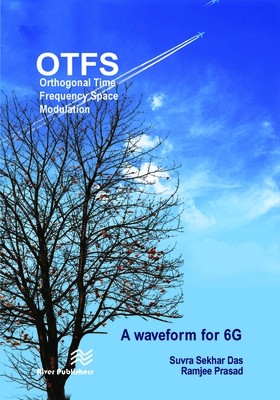
- We will send in 10–14 business days.
- Author: Suvra Sekhar Das
- Publisher: River Publishers
- ISBN-10: 8770226563
- ISBN-13: 9788770226561
- Format: 17.8 x 25.4 x 1.4 cm, kieti viršeliai
- Language: English
- SAVE -10% with code: EXTRA
Reviews
Description
Over the last few decades wireless communications, especially Mobile Communication Technology, has evolved by leaps and bounds. The mobile communication industry has named the different major changes as generations namely 1G, 2G, ..5G. We are presently looking at deployment of 5G technologies. The work for 6G has already started.
This book is focused on the waveform design of 6G. It presents a discourse on a potential waveform for 6G namely Orthogonal Time Frequency Space (OTFS) modulation. OTFS has a distinct feature when compared to earlier generation waveforms such that information bearing signal is placed in the delay Doppler domain as opposed to the usual placement of such signals in the time-frequency domain. This unique feature of OTFS enables it to overcome several disadvantages of a very popular and highly successful waveform namely Orthogonal Frequency Division Multiplexing (OFDM). OTFS is known to be more resilient to frequency offset and Doppler which is one of the key drawbacks of OFDM. With this feature, OTFS, can support higher mobility as well as higher frequency bands of operation which is also one of the key requirements of the next generation wireless communication technologies. The implementation complexity of OTFS remains comparable to that of OFDM. It is found that OTFS provides significant SNR advantage, higher resilience, lower PAPR, lower out of band signal leakage and higher multi-user spectral efficiency than that of OFDM. This book addresses- Fundamental signal model of OTFS. - Receiver design for OTFS- Channel estimation in OTFS- Multiple Access through non-orthogonal multiple access (NOMA-OTFS)
The contents of the books are primarily outcome of the research work done at the G. S. Sanyal School of Telecommunications, Indian Institute of Technology Kharagpur, Kharagpur, India.
Orthogonal Time Frequency Space Modulation: A waveform for 6G is ideal for personnel the wireless communication industry as well as academic staff and master/research students in electrical engineering with a specialization in wireless communications.
EXTRA 10 % discount with code: EXTRA
The promotion ends in 21d.17:25:06
The discount code is valid when purchasing from 10 €. Discounts do not stack.
- Author: Suvra Sekhar Das
- Publisher: River Publishers
- ISBN-10: 8770226563
- ISBN-13: 9788770226561
- Format: 17.8 x 25.4 x 1.4 cm, kieti viršeliai
- Language: English English
Over the last few decades wireless communications, especially Mobile Communication Technology, has evolved by leaps and bounds. The mobile communication industry has named the different major changes as generations namely 1G, 2G, ..5G. We are presently looking at deployment of 5G technologies. The work for 6G has already started.
This book is focused on the waveform design of 6G. It presents a discourse on a potential waveform for 6G namely Orthogonal Time Frequency Space (OTFS) modulation. OTFS has a distinct feature when compared to earlier generation waveforms such that information bearing signal is placed in the delay Doppler domain as opposed to the usual placement of such signals in the time-frequency domain. This unique feature of OTFS enables it to overcome several disadvantages of a very popular and highly successful waveform namely Orthogonal Frequency Division Multiplexing (OFDM). OTFS is known to be more resilient to frequency offset and Doppler which is one of the key drawbacks of OFDM. With this feature, OTFS, can support higher mobility as well as higher frequency bands of operation which is also one of the key requirements of the next generation wireless communication technologies. The implementation complexity of OTFS remains comparable to that of OFDM. It is found that OTFS provides significant SNR advantage, higher resilience, lower PAPR, lower out of band signal leakage and higher multi-user spectral efficiency than that of OFDM. This book addresses- Fundamental signal model of OTFS. - Receiver design for OTFS- Channel estimation in OTFS- Multiple Access through non-orthogonal multiple access (NOMA-OTFS)
The contents of the books are primarily outcome of the research work done at the G. S. Sanyal School of Telecommunications, Indian Institute of Technology Kharagpur, Kharagpur, India.
Orthogonal Time Frequency Space Modulation: A waveform for 6G is ideal for personnel the wireless communication industry as well as academic staff and master/research students in electrical engineering with a specialization in wireless communications.


Reviews